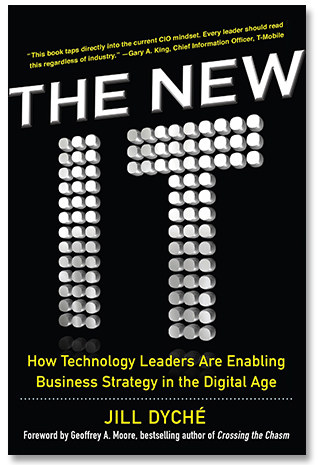The New IT, book review: Business advice with a cutting edge


The frustration among business teams is clear, as Dyché illustrates with a letter she gets a marketing group to write to their IT team, expressing exactly how they feel about them -- missing in action, too busy complaining that the business isn't telling them what they need and digging into technical details they don't care about to deliver the very specific shopping list the department actually needs. But before you wince in sympathy and start thinking about how much that sounds like your own IT team, read the letter back from the IT department explaining that 'no, you can't have a powerful custom system for the cost of a simple phone app and no, we can't throw away everything and build you what you want, because we have to keep it all running, and you can't tell us what you're going to need in time for us to build it'.
If talk of big data for business leaves you wondering how any of that will help you, because your IT team is busy worrying if you can still pass an audit if all your users are installing apps that cache their email credentials in the cloud just to get their messages prioritised, then this is the book for you. You'll find it especially useful if you see what an opportunity there is as we move from systems of record that never actually match the way things are done in your business, to systems of engagement that can show you exactly what customers and suppliers and employees are doing, but you don't know how to get there from where you are today, knee-deep in monthly patch testing, requirements-gathering and shadow IT -- a typical combination that Dyché neatly labels 'pitch and patch'.
She does an excellent job cataloguing the range of disagreements and dysfunctions in businesses that make this tension worse. You should be able to spot your own problem and your own boss pretty easily, whether that's issues with existing systems being mistaken for an IT department that can't deliver, a business that doesn't know what its strategy is, or a CIO stuck with looking after operational problems instead of getting a chance to deliver that strategy.
Quizzes and practical advice
Dyché's suggestions for fighting your way out of those weeds come from wide experience with many companies, so you're very likely to find what you thought were your own unique problems in her list of different IT cultures -- from the tactical team who 'keeps the lights on' but gets counted as an overhead rather than an asset, to executives who proclaim that 'data is the new oil' but don't want to invest in systems to generate data or to power analytics and BI, because they think they can just drill into their existing systems to get a gushing data well. As well as skewering a few familiar pretensions and pointing out the risks and benefits of all these approaches, She includes useful tips for spotting when each strategy is working well and how to make the most of it.
When you first start reading The New IT: How Technology Leaders Are Enabling Business Strategy in the Digital Age, you're likely to think that it's well enough written that you won't need the careful introduction, laying out who needs to read which chapter and why. However, it's dense and you can't fly through it in a single reading. There are three lengthy quizzes to help you identify where you and your business really are on the scale of fossilized to integrated IT, and practical advice on generating strategy maps and diagrams. You're also shown how to score a portfolio of projects, organise your business around service lines rather than departments, and draw lines in the sand that legitimise shadow IT but use formal agreements that force the business team to take responsibility for problems as well as successes. These will take a long time to work through, because they need to distil what's actually happening, which is what transforms a process from glib to useful.
These chapters are detailed enough that they could be a guide to changing things in your company, or they could be a wake-up call if you realise your company would never consider change. Dyché has a sharp sense of humour, expanding ERP as 'Everyone Ruining Processes', comparing a manager tinkering with an org chart to a dog happily chewing a bone, and noting that "there's nothing more dangerous than a CEO who's just read an airline magazine". It's funniest when she is mocking what doesn't work, which she does with brutal honesty borne of experience. If it ever feels like Dilbert in your company, you'll either laugh or weep at some of the comments, but she's practical rather than malicious. Do you have governance issues, or do you just need better accountability and clearer executive communication? Her questions both underline the problem and suggest an approach for solving it.
You don't expect books about the status of business and IT to be funny, and if they are you don't expect them to be useful as well. The New IT isn't a comedy, even when it catalogues familiar comedies of errors. It's funny because it's about real experiences, and it's useful because it's realistic. It's so readable because that realism is leavened by a healthy dose of cynicism and practicality, which is an appealing combination.